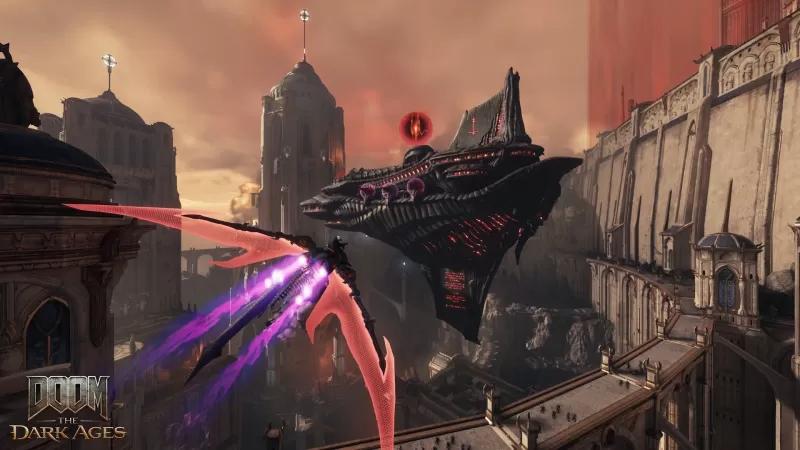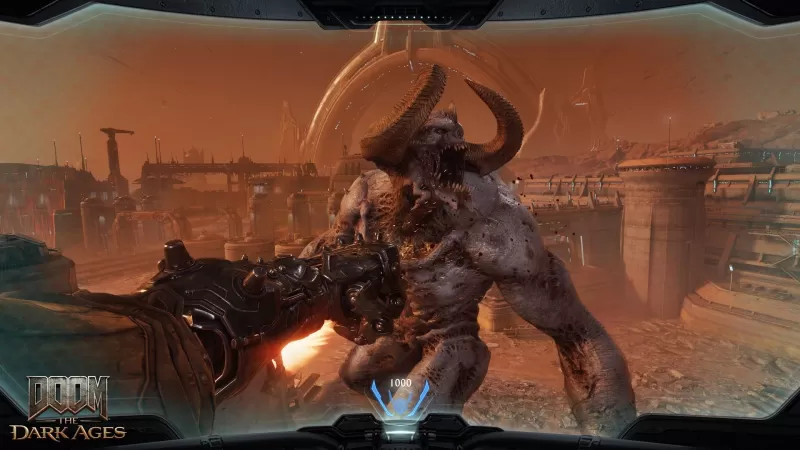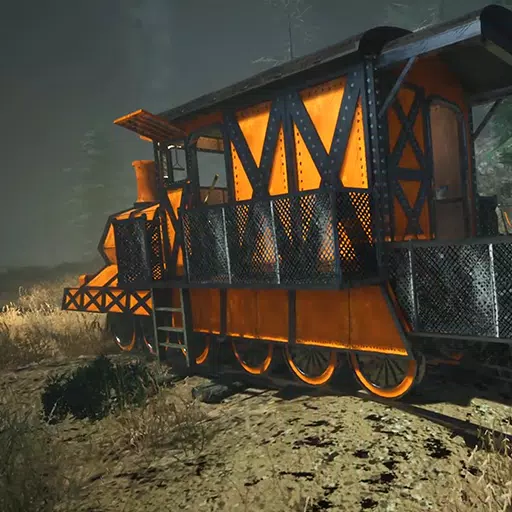Playing Doom: The Dark Ages, I was unexpectedly reminded of Halo 3. During a recent hands-on demo with id Software's gothic prequel, I found myself mounted on a cyborg dragon, unleashing a salvo of machine gun fire across the side of a demonic battle barge. After destroying the vessel's defensive turrets, I landed my beast atop the ship and charged through its lower decks, turning the crew into a red slop. Moments later, I burst through the hull, leaping back onto my dragon to continue my crusade against the machines of Hell.
Fans of Bungie's landmark Xbox 360 shooter will recognize the resemblance to Master Chief's assault on the Covenant's scarab tanks. The helicopter-like Hornet has been replaced by a holographic-winged dragon, and the giant laser-firing mech by an occult flying boat, but the essence remains: an aerial assault transitioning into a devastating boarding action. Interestingly, this wasn't the only Halo-like moment in the demo. While The Dark Ages' combat core is unmistakably Doom, the campaign's design evokes a "late-2000s shooter" vibe with its elaborate cutscenes and emphasis on gameplay novelty.

Over two and a half hours, I played four levels of Doom: The Dark Ages. The campaign's opener resembled the tightly-paced, intricately designed levels of Doom (2016) and its sequel. However, the other levels saw me piloting a colossal mech, flying the aforementioned dragon, and exploring wide-open battlefields filled with secrets and powerful minibosses. This marks a significant departure from Doom's traditional focus on mechanical purity, instead resembling the likes of Halo, Call of Duty, and even old James Bond games like Nightfire, all known for their scripted setpieces and novel mechanics.
This direction is intriguing because Doom once turned away from such elements. The cancelled Doom 4 was set to resemble Call of Duty, with a modern military aesthetic and increased focus on characters, cinematic storytelling, and scripted events. After years of development, id Software decided these ideas didn't fit the series, opting for the more focused Doom (2016). Yet, here we are in 2025, with The Dark Ages incorporating them.
The campaign's fast pace is interspersed with new gameplay ideas reminiscent of Call of Duty's most memorable novelties. My demo began with a long, elaborate cutscene introducing the realm of Argent D'Nur, the opulent Maykrs, and the Night Sentinels—the knightly brothers-in-arms of the Doom Slayer. The Slayer is depicted as a terrifying legend, a nuclear-level threat on two legs. This lore, familiar to Doom obsessives, is presented in a deeply cinematic way, reminiscent of Halo. This continues into the levels, where NPC Night Sentinels are scattered throughout the environment, similar to UNSC Marines, creating a sense of being part of an army, with the player as the invincible spearhead.
The introductory cutscene includes a lot of character work, and it remains to be seen if this is necessary for Doom. I prefer the subtle storytelling of the previous games through environment design and codex entries, with cinematics reserved for major reveals like in Eternal. However, the cutscenes in The Dark Ages are well-placed, setting up missions without interrupting Doom's intense flow.
There are other interruptions, though. After the opening mission, which starts with shotgun slaughter and ends with parrying Hell Knights using the Slayer's new shield, I piloted the Pacific Rim-like Atlan mech to battle demonic kaiju. Then, I soared on a cybernetic dragon, taking down battle barges and gun emplacements. These tightly scripted levels introduce significant shifts in gameplay, reminiscent of Call of Duty's novel sequences like the AC-130 gunship in Modern Warfare or the dogfighting missions in Infinite Warfare. The Atlan is slow and heavy, making Hell's armies look like Warhammer miniatures, while the dragon is fast and agile, offering a different experience from classic Doom.

Many of the best FPS campaigns thrive on variety, like Half-Life 2 and Titanfall 2. Halo's mix of vehicular and on-foot sequences adds rich texture to its gameplay. However, I'm uncertain if this will work for Doom. The Dark Ages remains a wonderfully complex shooter, demanding complete attention with its shots, shield tosses, parries, and brutal melee combos. In contrast, the mech and dragon sequences feel simplistic and almost on-rails, resembling QTEs.
In Call of Duty, switching to a tank or gunship works because the mechanical complexity isn't far removed from the on-foot missions. In The Dark Ages, there's a clear divide between gameplay styles, making the transition feel jarring. While Doom's core combat is the star, even when I'm beating a giant demon with a rocket-powered mech punch, I found myself longing for the ground combat with a double-barreled shotgun.
My final hour of play shifted to a different style, focusing on id's best-in-class gunplay in a huge open battlefield. The "Siege" level, aimed at destroying five Gore Portals, has the same energy as Call of Duty's multi-objective missions, yet reminded me of Halo. The grand scale of the map versus the tighter routes of the opening level evokes the contrast between Halo's interior and exterior environments. The core shooter systems are given new context in larger spaces, requiring players to rethink weapon ranges, employ charge attacks to cover vast distances, and use the shield to deflect artillery.
Expanding Doom's playspace can lead to unfocused gameplay, with backtracking and empty pathways killing the pace. I believe integrating the dragon like a Halo Banshee could maintain the pace and make it more integral to the experience. If such a level exists beyond what I've seen, it would be a welcome addition.
Despite the overall shape of the full campaign, I'm fascinated by the resurrection and reinterpretation of ideas once considered ill-fitting for the series. A Kotaku report from 2013 described the cancelled Doom 4 as having many scripted set pieces, including an obligatory vehicle scene, which is exactly what we see in the Atlan and dragon sections. Marty Stratton from id Software confirmed in a 2016 Noclip interview that Doom 4 was closer to Call of Duty, with more cinematic elements, story, and characters. It's fascinating to see these elements return in The Dark Ages, featuring big boarding action setpieces, lusciously rendered cinematics, a wider cast of characters, and significant lore reveals.
The question remains: were these ideas always a bad fit for Doom, or were they just bad when they resembled Call of Duty too closely? While I share the skepticism of fans who once decried "Call of Doom," I'm also excited about id Software's attempt to integrate these elements into the modern Doom formula.
The core of The Dark Ages is undoubtedly its on-foot, gun-in-hand combat. Nothing in the demo suggested it wouldn't be the main focus, and everything I played reaffirmed its status as another fantastic reinvention of Doom's core. While this alone could support an entire campaign, id Software has other plans. Some of the new ideas feel mechanically slim, and I'm concerned they might detract rather than enhance the experience. However, there's still much to see, and only time will tell how these demo missions fit into the larger context. I eagerly await May 15th, not just to return to id's unrivaled gunplay, but to see if Doom: The Dark Ages will be a successful late-2000s FPS campaign or a messy one.







